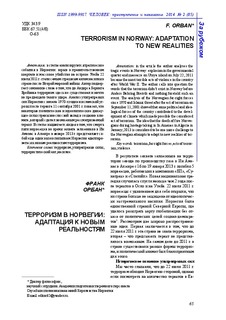| dc.contributor.author | Orban, Franck | |
| dc.date.accessioned | 2014-06-25T12:06:50Z | |
| dc.date.accessioned | 2014-08-25T08:18:15Z | |
| dc.date.available | 2014-06-25T12:06:50Z | |
| dc.date.available | 2014-08-25T08:18:15Z | |
| dc.date.issued | 2014 | |
| dc.identifier.citation | Man: Crime and Punishment 2014, 85(2):65-73 | |
| dc.identifier.issn | 1999-9917 | |
| dc.identifier.uri | http://hdl.handle.net/11250/217963 | |
| dc.description.abstract | In the article the author analyses the
tragic events in Norway: explosion in the governmental
quarter and massacre on Utoya island on July 22, 2011
became the most terrible acts of violence in the country
after World War II. The author calls into question the
words that the terrorism didn’t exist in Norway before
Anders Behring Breivik and nothing foretold such an
event. The analysis of the Norwegian far-right forces
since 1970 and Islamic threat after the act of terrorism on
September 11, 2001 showed that some political and ideological
forces of the country contributed to the development
of climate which made possible the considered
act of terrorism. The idea that the death of five Norwegians
during hostage taking in In Amenas in Algeria in
January, 2013 is considered to be one more challenge to
the Norwegian attempts to adapt to new realities of terrorism. | |
| dc.language.iso | rus | |
| dc.title | Терроризм в Норвегии: адаптация к новым реальностям | |
| dc.title.alternative | Terrorism in Norway: adaptation to new realities | |
| dc.type | Journal article | |
| dc.date.updated | 2014-06-25T12:06:50Z | |
| dc.identifier.cristin | 1140700 | |
